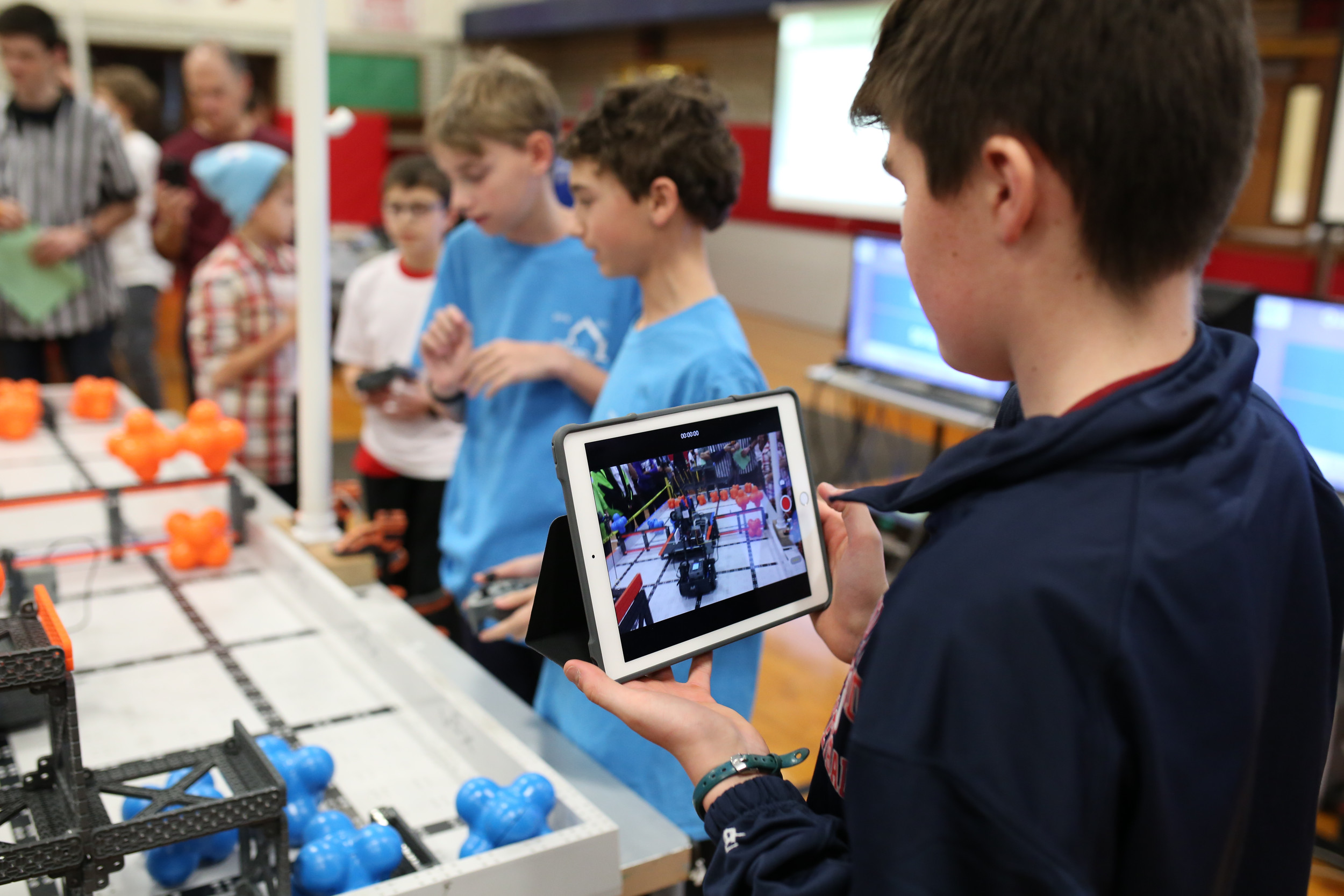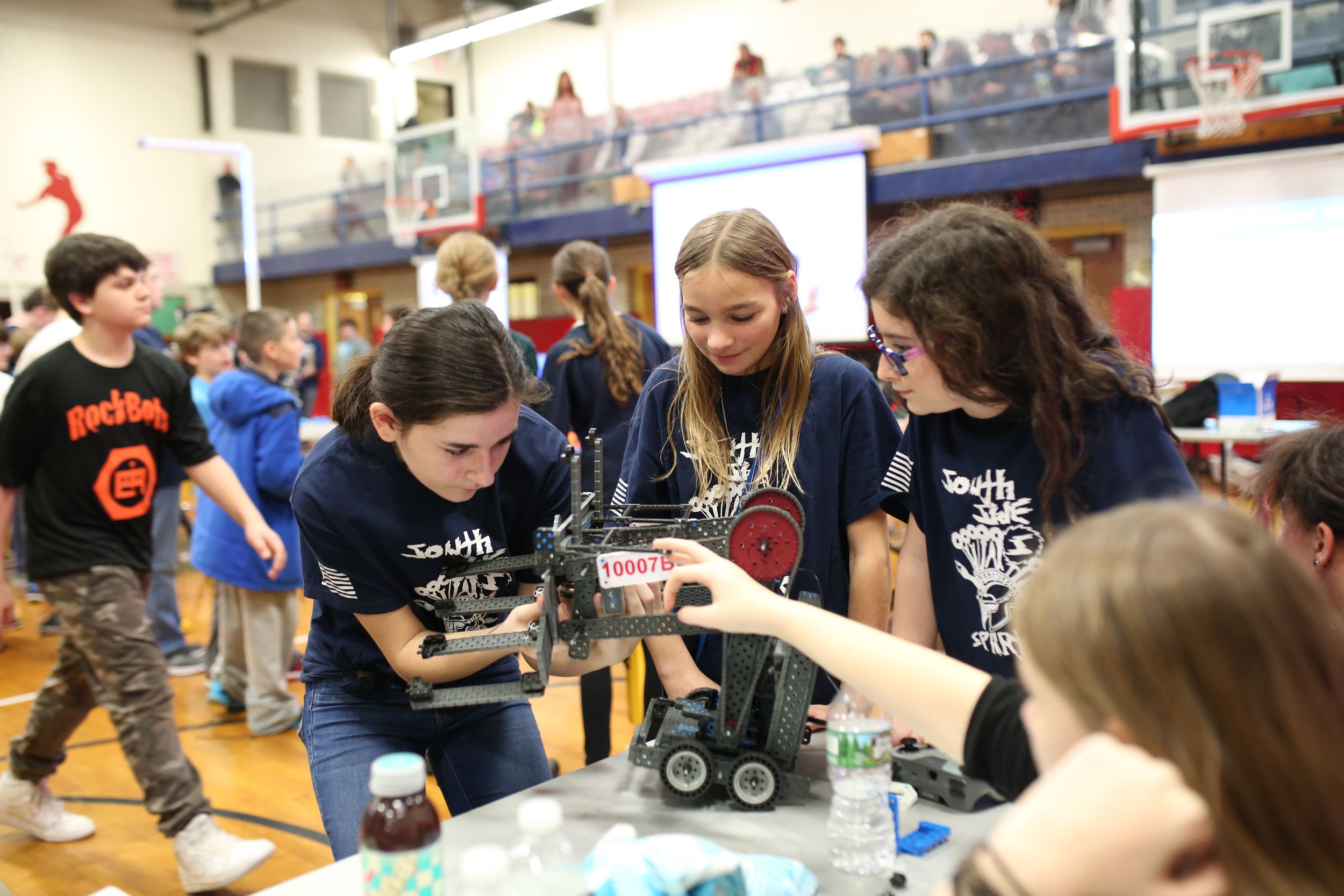The case for robotics
South Side Middle School was packed with students from seven school districts in Nassau County and New York City for the latest Vex IQ Robotics Challenge on Jan. 12.
On each of three contest tables, two pairs of competitors drove their robots around a field, knocking plastic stars off a fence and maneuvering the devices into either the corners of the table or double-stacked squares to score points.
Other players gathered around the tables to watch the one-minute-long matches, often recording them on smartphones or tablets. The biggest cheers came when both pairs of handlers balanced their robots on a see-saw-like bridge that separated the two sides.
At the sides and back of the room, middle-schoolers feverishly tried to modify their robots by fixing or replacing damaged or lost parts, or practiced their moves on sample tables in preparation for their next matches.
Welcome to the world of robotics, which is quickly becoming the newest school club, er, sports craze.
Students are introduced to the program at the middle-school level. They gather several times a week for hours at a time, trying to build the perfect robot that will stand out in competition. If school time wasn’t enough, the kids made up for it by meeting at one another’s houses to perfect their creations.
“It’s unique, because most sports involve physical education, and not everyone likes that,” said seventh-grader Ruthie Moradi. “We really take a lot of pride in it and a lot of time and effort, so this is our sport.”
Preparation and practice paid off for the South Side team last April, when it advanced to the Vex IQ Challenge world championship in Louisville, Ky., and competed against players from around the world. The opening ceremonies were reminiscent of the Olympics, with teams from each country entering the Kentucky Exposition Center together, waving their respective flags.
“It was really a lot of fun, and we got to meet people from all over the world,” said South Side eighth-grader Alisa Barker. “It was fun to see what other worlds are like.”
Word of the team’s success got around, making it easier to recruit new members. There are now a total of about 40, a dozen of whom took part in this month’s competition.
Seventh-grader Ryan Varley was one of the new members who joined thanks to word of mouth. “I was just hearing about this, and I really thought, ‘That’s really interesting — I want to do that,’” he said. “I think it’s really good, because it’s taught me a lot of leadership qualities, and [the robots are made] all by ourselves.”
Technology teachers Ryan Bockelman and Dan LaManna are the middle school team advisers, and are often credited by the students and their parents for the growth of the program. Bockelman has fielded the Vex IQ team for three years and the robotics group for four.
“We started with a group of about 10 kids,” Bockelman recalled. “The following year we bumped it up to about 80 after some kids heard. The next year we bumped it to 160, and then we had to start doing cuts, and this year we have 40 kids. I had no idea it would go this big.”
Students can continue their involvement in robotics at South Side High School, but that group meets only twice a week, for two hours at a time.
Competitors at all levels learn the dreaded f-word: funding. Middle school team members wear navy blue T-shirts at their competitions, which they designed themselves. The back of the shirt features the logos of eight sponsors, including the Rockville Centre Education Foundation and art and self-defense studios.
“Funding is always a concern,” said Bockelman. “It’s pretty expensive to do this. A lot of parents and local businesses in Rockville Centre all gave us a little bit of money to help us keep going.”
Members of the freshman team, who served as referees and scorekeepers for the middle school meet, addressed the school board at its December and January meetings, reading letters to the people who control their collective fate.
“It was an anxious nervousness,” freshman Chris Kakis recounted. “We’ve been trying to get more funding, because these clubs are the future.”
Varley read one of the letters at the December meeting. “I heard that some of the high schoolers barely have a program up there,” he said, “and I don’t want all this to stop down here and I never get the opportunity to do it up there.”
South Side High School Principal John Murphy is a strong advocate of the program, which falls under the school’s STEAM (science, technology, engineering, art and math) initiative.
“It behooves us to really look actively in terms of supporting it,” Murphy said at the Jan. 18 board meeting. “It’s grown in leaps and bounds, and I’d like to thank the parents and the students who both advocated for it at the last meeting and who have been ongoing in terms of giving us advice.” There is an ongoing need for financial support for the club, he added.
Superintendent William Johnson said that trustees would look closely at the budget and try to find money to support the program.
“The will is to get something done — it’s certainly there,” Johnson told the students. “We see what it means to you, we saw what it meant to you in the middle school, and we’re certainly going to do everything we possibly can both as a board and an administration to see that something very meaningful happens in your lives.”
For the time being, however, advisers, students and parents may have to keep relying on hope and the generosity of others to keep the program going.

 50.0°,
Overcast
50.0°,
Overcast 







